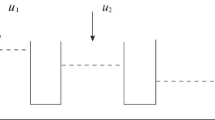The problem of increasing the efficiency of technical systems by methods of functional diagnostics using virtual sensors is described in cases where the available physical sensors are not enough to reduce the complexity of diagnostic tools or to localize defects with the required depth. The use of additional physical sensors to achieve the desired result may require additional costs, in addition, the reliability of such sensors is usually low. The problem of constructing robust virtual sensors for technical systems described by nonlinear models under the action of external disturbances has been posed and solved. Two ways of solving this problem are proposed based on the identification and Jordan canonical forms. Relations are given that allow constructing a sensor of minimal complexity for estimating a given component of the state vector of a technical system. In this case, the constructed sensor will be insensitive or minimally sensitive to perturbations, which is achieved by using the singular value decomposition of matrices describing the perturbations and the original system. The synthesized virtual sensor can become an addition to the existing physical sensors or replace a failed physical sensor. Theoretical provisions are illustrated with a practical example. The results obtained can be used to solve problems of building fault-tolerant systems.

Similar content being viewed by others
References
M. Blanke, M. Kinnaert, J. Lunze, and M. Staroswiecki, Diagnosis and Fault-Tolerant Control, Springer-Verlag, Berlin (2006), https://doi.org/10.1007/978-3-540-35653-0.
M. Witczak, Fault Diagnosis and Fault Tolerant Control Strategies for Nonlinear Systems, Springer, Berlin (2014), https://doi.org/10.1007/978-3-319-03014-2.
Q. Ahmed, A. Bhatti, and M. Iqbal, IEEE Sens. J., 11, No. 9, 1832–1840 (2011), https://doi.org/10.1109/JSEN.2011.2105471.
G. Heredia and A. Ollero, Sensors, 10, 2188–2201 (2010), https://doi.org/10.3390/s100302188.
Z. Hosseinpoor, M. Arefi, R. Razavi-Far, et al., “Virtual sensors for fault diagnosis: a case of induction motor broken rotor bar,” IEEE Sens. J., 21, No. 4, 5044–5051 (2021).
Y. Wang, D. Rotondo, V. Puig, and G. Cembrano, IEEE T. Circ. Syst., 67, No. 12, 5316–5325 (2020), https://doi.org/10.1109/TCSI.2020.3015887.
A. N. Zhirabok and Kim Chung Ir, “Virtual sensors in the problem of functional diagnostics of nonlinear systems,” Izv. RAN. Teor. Sist. Upravl., No. 1, 40–48 (2022), https://doi.org/10.31857/S0002338822010139;J. Comp. Syst. Sci. Int., 61, 38–46 (2022), https://doi.org/10.1134/S1064230722010130.
A. N. Zhirabok, A. V. Zuev, O. Yu. Sergienko, and A. E. Shumsky, “Identification of defects in nonlinear dynamic systems and their sensors based on moving observers,” Avtomat. Telemekh., No. 2, 63–89 (2022), https://doi.org/10.31857/S0005231022020052;Automat. Remote Control, 83, 214–236 (2022), https://doi.org/10.1134/S0005117922020059.
A. N. Zhirabok, A. V. Zuev, and A. E. Shumsky, “Identification of defects in sensors of technical systems using moving observers,” Izmer. Tekhn., No. 10, 21–28 (2019), https://doi.org/10.32446/0368-1025it.2019-10-21-28;Measur. Techn., 62, No. 10, 869–878 (2020), https://doi.org/10.1007/s11018-020-01707-1.
X. Low, A. Willsky, and G. Verghese, Automatica, 22, 333–344 (1986), https://doi.org/10.1016/0005-1098(86)90031-2.
E. Misawa and J. Hedrick, J. Dyn. Syst., Measur., Control, 111, 344–352 (1989), https://doi.org/10.1115/1.3153059.
Author information
Authors and Affiliations
Corresponding author
Additional information
Translated from Izmeritel’naya Tekhnika, No. 6, pp. 17–22, June, 2022.
Rights and permissions
Springer Nature or its licensor (e.g. a society or other partner) holds exclusive rights to this article under a publishing agreement with the author(s) or other rightsholder(s); author self-archiving of the accepted manuscript version of this article is solely governed by the terms of such publishing agreement and applicable law.
About this article
Cite this article
Zhirabok, A.N., Zuev, A.V., Protcenko, A.A. et al. Methods of Robust Virtual Sensor Design. Meas Tech 65, 405–411 (2022). https://doi.org/10.1007/s11018-022-02097-2
Received:
Accepted:
Published:
Issue Date:
DOI: https://doi.org/10.1007/s11018-022-02097-2




